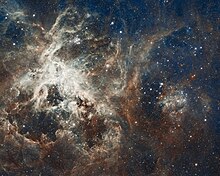Tập tin:30 Doradus, Tarantula Nebula.jpg

Kích thước hình xem trước: 749×599 điểm ảnh. Độ phân giải khác: 300×240 điểm ảnh | 600×480 điểm ảnh | 960×768 điểm ảnh | 1.280×1.024 điểm ảnh | 2.560×2.048 điểm ảnh | 20.323×16.259 điểm ảnh.
Tập tin gốc (20.323×16.259 điểm ảnh, kích thước tập tin: 99,35 MB, kiểu MIME: image/jpeg)
| Đây là một hình ảnh đã được chọn làm hình ảnh chọn lọc và được giới thiệu trên Trang Chính của Wikipedia tiếng Việt. |
Lịch sử tập tin
Nhấn vào ngày/giờ để xem nội dung tập tin tại thời điểm đó.
| Ngày/giờ | Hình xem trước | Kích cỡ | Thành viên | Miêu tả | |
|---|---|---|---|---|---|
| hiện tại | 18:35, ngày 8 tháng 7 năm 2012 |  | 20.323×16.259 (99,35 MB) | Prof. Professorson | Higher resolution, converted from http://spacetelescope.org/static/archives/images/original/heic1206a.tif. |
| 12:13, ngày 19 tháng 4 năm 2012 |  | 2.340×1.847 (2,52 MB) | Dipankan001 |
Trang sử dụng tập tin
Có 3 trang tại Wikipedia tiếng Việt có liên kết đến tập tin (không hiển thị trang ở các dự án khác):
Sử dụng tập tin toàn cục
Những wiki sau đang sử dụng tập tin này:
- Trang sử dụng tại af.wikipedia.org
- Trang sử dụng tại ar.wikipedia.org
- Trang sử dụng tại be-tarask.wikipedia.org
- Trang sử dụng tại bn.wikipedia.org
- Trang sử dụng tại crh.wikipedia.org
- Trang sử dụng tại cs.wikipedia.org
- Trang sử dụng tại cv.wikipedia.org
- Trang sử dụng tại de.wikipedia.org
- Trang sử dụng tại en.wikipedia.org
- Tarantula Nebula
- User talk:Sam Spade/ - archive/November 2005
- User:Solipsist/notes
- Starburst region
- Wikipedia:Picture of the day/Archive
- User talk:Sam Spade/ - archive/Januar 2006
- User talk:Sam Spade/ - archive/März 2006
- User:Ppntori
- User talk:Ancheta Wis/archive1
- User:LeMaster
- Talk:Tarantula Nebula
- Template:POTD/Day
- User:Zamphuor
- Wikipedia:WikiProject Astronomy/Recognized content
- User:EvokeNZ
- User:...adam.../stuff/7
- User talk:Malzees
- User:Consci
- User:SaltyDawg
- User talk:Funky Fantom
- User:Holyroller07
- Wikipedia:Featured pictures/Space/Looking out
- User:North8000
- User:Marquinhos
- User:Nferenc
- User:Quellus/sandbox2
- Wikipedia:Teahouse/Guests
- Wikipedia:Teahouse/Guest profile summary
- Wikipedia:Teahouse/Guest profile summary/Avatars
- Wikipedia:Teahouse/Guests/Left column
- Wikipedia:Teahouse/Guests/Right column
- Wikipedia:Teahouse/Guest book
- User:The Determinator/Userpage/Top/Image
- Wikipedia:WikiProject Astronomy/Recognized astronomy content
- Wikipedia:Teahouse/Guest book/Archive 6
- Wikipedia:Teahouse/Guest/Featured/21
- Wikipedia:Teahouse/Guest/Featured/22
- Wikipedia:Teahouse/Guest book/Archive 12
- Wikipedia:Teahouse/Guest book/Archive 13
- Wikipedia:Teahouse/Guest book/Archive 14
- Wikipedia:Teahouse/Guest book/Archive 15
Xem thêm các trang toàn cục sử dụng tập tin này.



